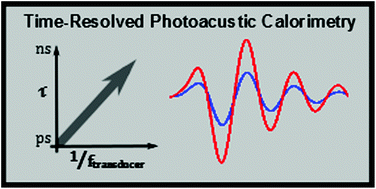Assessment of lifetime resolution limits in time-resolved photoacoustic calorimetry vs. transducer frequencies: setting the stage for picosecond resolution
Abstract
Time-resolved photoacoustic calorimetry (PAC) gives access to lifetimes and energy fractions of reaction intermediates by deconvolution of the photoacoustic wave of a sample (E-wave) with that of the instrumental response (T-wave). The ability to discriminate between short lifetimes increases with transducer frequencies employed to detect the PAC waves. We investigate the lifetime resolution limits of PAC as a function of the transducer frequencies using the instrumental response obtained with the photoacoustic reference 2-hydroxybenzophenone in toluene or acetonitrile. The instrumental response was obtained for a set of transducers with central frequencies ranging from 0.5 MHz up to 225 MHz. The simulated dependence of the lifetime resolution with the transducer frequencies was anchored on experimental data obtained for the singlet state of naphthalene with a 2.25 MHz transducer. The shortest lifetime resolved with the 2.25 MHz transducer was 19 ns and our modelling of the transducer responses indicates that sub-nanosecond lifetimes of photoacoustic transients can be resolved with transducers of central frequencies above 100 MHz.



 Please wait while we load your content...
Please wait while we load your content...